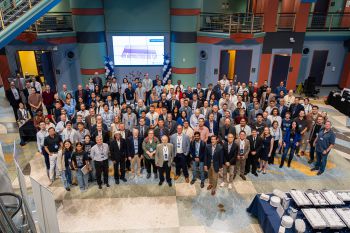C60 at 40: Sussex Reflects on the Legacy of Sir Harry Kroto and a Homegrown Nobel Discovery
By: Meganne Tillay
Last updated: Tuesday, 28 October 2025

To mark 40 years since the discovery of C₆₀ – Buckminsterfullerene – academics from the University of Sussex travelled to Rice University in Texas for a celebration of this revolutionary moment in chemistry. We spoke with Professor Hazel Cox and Professor Paul Nightingale about their experiences at the event, the enduring impact of Sir Harry Kroto’s work, and how Sussex continues to shape scientific discovery.
Q: What was the atmosphere like at the C60 at 40 conference?
Hazel Cox: It was fantastic, they put together such an exciting and thoughtful programme. The first day focused on the history of the discovery, and it was wonderful to meet the original PhD students who were there when C₆₀ was first discovered. There was a real sense of pride in the partnership between Rice and Sussex.
Paul Nightingale: Yes, I was struck by how warmly Sussex was recognised. The organisers didn’t treat us as a footnote; they celebrated us as an equal partner. It really reminded us how central Sussex was to that story.
Q: What were your main takeaways from the event?
Paul Nightingale: The scale of innovation that has come from C₆₀ is staggering; from nanotechnology to materials science, diagnostics and even drug delivery. The US has invested heavily in translating this kind of research into real-world impact, and that’s a lesson for us in the UK. These things take time, but once they mature, they completely reshape industries.
Hazel Cox: I was amazed by the diversity of applications in neuroscience, cancer treatment, photonics, spintronics, even quantum optics. You realise that what started as fundamental chemistry now spans so many disciplines.
Q: How was Sir Harry Kroto remembered at the event?
Hazel Cox: Beautifully. His wife Margaret and son Stephen were there, and Rice made a huge effort to honour his legacy. They showcased banners, and played our video, which recognises Harry’s key role in naming Buckminsterfullerene. Students were even asking Margaret for autographs; it was very touching.
Paul Nightingale: Harry was passionate about science communication and education. He used his Nobel Prize winnings to set up the Vega Science Trust to make science accessible to everyone. That commitment to inspiring young people is still felt at Sussex today.
Q: What do you remember personally about Harry Kroto?
Hazel Cox: He was a wonderful human being: supportive, generous and encouraging, especially to early-career scientists and women in science. He believed completely in nurturing the next generation.
Paul Nightingale: He was also great fun: curious about everything, creative, and always focused on sharing science with the public.
Q: How does Sussex continue to build on his legacy?
Hazel Cox: We now have the Kroto Science Education Room on campus, filled with memorabilia donated by Margaret Kroto and original samples from Jonathan Hare. It has become a focal point for inspiring future scientists.
Paul Nightingale: He has inspired others profoundly in making a change. Sussex still punches above its weight in research. We’ve produced six Nobel laureates – three in chemistry – and continue to lead in materials science, nanotechnology and quantum innovation.
Q: What’s next for Sussex and C₆₀?
Hazel Cox: Next year marks 30 years since Harry received the Nobel Prize, and we’ll be celebrating on 6 October 2026 with a day-long event at the Attenborough Centre. The morning will focus on the history and discovery, and the afternoon will highlight modern applications and Sussex’s ongoing research.
Q: Any final thoughts?
Paul Nightingale: Sussex played a key role in one of the great scientific discoveries of the 20th century. We should be proud of that and keep telling the story.
Hazel Cox: A huge thank you to Rice University and the British Consulate in Houston for their incredible hospitality and support in making the celebration so special.
